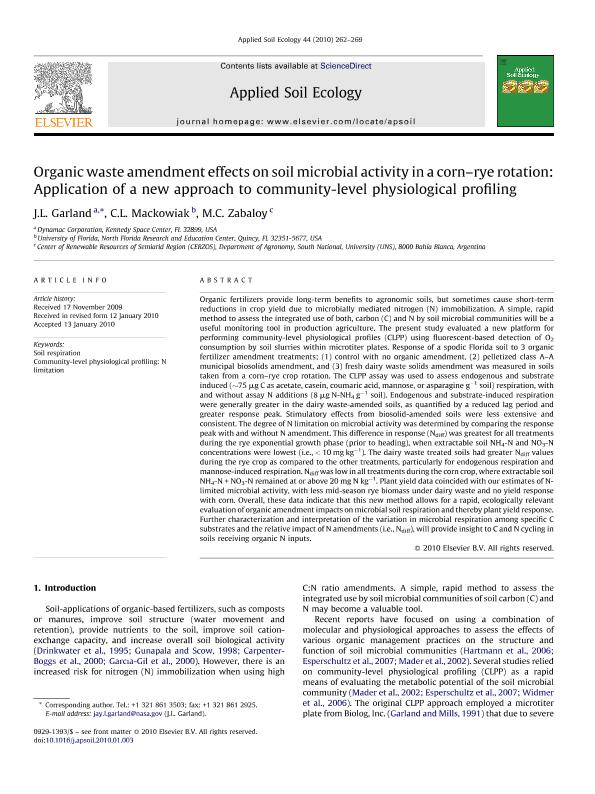Mostrar el registro sencillo del ítem
dc.contributor.author
Garland, J. L.
dc.contributor.author
Mackowiak, C. L.

dc.contributor.author
Zabaloy, Maria Celina

dc.date.available
2017-05-26T18:46:11Z
dc.date.issued
2010-03
dc.identifier.citation
Garland, J. L.; Mackowiak, C. L.; Zabaloy, Maria Celina; Organic waste amendment effects on soil microbial activity in a corn-rye rotation: Application of a new approach to community-level physiological profiling; Elsevier Science; Applied Soil Ecology; 44; 3; 3-2010; 262-269
dc.identifier.issn
0929-1393
dc.identifier.uri
http://hdl.handle.net/11336/16984
dc.description.abstract
Organic fertilizers provide long-term benefits to agronomic soils, but sometimes cause short-term reductions in crop yield due to microbially mediated nitrogen (N) immobilization. A simple, rapid method to assess the integrated use of both, carbon (C) and N by soil microbial communities will be a useful monitoring tool in production agriculture. The present study evaluated a new platform for performing community-level physiological profiles (CLPP) using fluorescent-based detection of O2 consumption by soil slurries within microtiter plates. Response of a spodic Florida soil to 3 organic fertilizer amendment treatments; (1) control with no organic amendment, (2) pelletized class A?A municipal biosolids amendment, and (3) fresh dairy waste solids amendment was measured in soils taken from a corn?rye crop rotation. The CLPP assay was used to assess endogenous and substrate induced (∼75 μg C as acetate, casein, coumaric acid, mannose, or asparagine g−1 soil) respiration, with and without assay N additions (8 μg N-NH4 g−1 soil). Endogenous and substrate-induced respiration were generally greater in the dairy waste-amended soils, as quantified by a reduced lag period and greater response peak. Stimulatory effects from biosolid-amended soils were less extensive and consistent. The degree of N limitation on microbial activity was determined by comparing the response peak with and without N amendment. This difference in response (Ndiff) was greatest for all treatments during the rye exponential growth phase (prior to heading), when extractable soil NH4-N and NO3-N concentrations were lowest (i.e., < 10 mg kg−1). The dairy waste treated soils had greater Ndiff values during the rye crop as compared to the other treatments, particularly for endogenous respiration and mannose-induced respiration. Ndiff was low in all treatments during the corn crop, where extractable soil NH4-N + NO3-N remained at or above 20 mg N kg−1. Plant yield data coincided with our estimates of N-limited microbial activity, with less mid-season rye biomass under dairy waste and no yield response with corn. Overall, these data indicate that this new method allows for a rapid, ecologically relevant evaluation of organic amendment impacts on microbial soil respiration and thereby plant yield response. Further characterization and interpretation of the variation in microbial respiration among specific C substrates and the relative impact of N amendments (i.e., Ndiff), will provide insight to C and N cycling in soils receiving organic N inputs.
dc.format
application/pdf
dc.language.iso
eng
dc.publisher
Elsevier Science

dc.rights
info:eu-repo/semantics/openAccess
dc.rights.uri
https://creativecommons.org/licenses/by-nc-nd/2.5/ar/
dc.subject
Soil Respiration
dc.subject
Community Level Physiological Profiling
dc.subject
N Limitation
dc.subject.classification
Biología Celular, Microbiología

dc.subject.classification
Ciencias Biológicas

dc.subject.classification
CIENCIAS NATURALES Y EXACTAS

dc.subject.classification
Ciencias del Suelo

dc.subject.classification
Agricultura, Silvicultura y Pesca

dc.subject.classification
CIENCIAS AGRÍCOLAS

dc.title
Organic waste amendment effects on soil microbial activity in a corn-rye rotation: Application of a new approach to community-level physiological profiling
dc.type
info:eu-repo/semantics/article
dc.type
info:ar-repo/semantics/artículo
dc.type
info:eu-repo/semantics/publishedVersion
dc.date.updated
2017-05-10T14:21:12Z
dc.journal.volume
44
dc.journal.number
3
dc.journal.pagination
262-269
dc.journal.pais
Países Bajos

dc.journal.ciudad
Amsterdam
dc.description.fil
Fil: Garland, J. L.. Dynamic Corporation. Kennedy Space Center; Estados Unidos
dc.description.fil
Fil: Mackowiak, C. L.. University Of Florida. Florida Museum Of History; Estados Unidos
dc.description.fil
Fil: Zabaloy, Maria Celina. Consejo Nacional de Investigaciones Científicas y Técnicas. Centro Científico Tecnológico Conicet - Bahía Blanca. Centro de Recursos Naturales Renovables de la Zona Semiarida. Universidad Nacional del Sur. Centro de Recursos Naturales Renovables de la Zona Semiarida; Argentina
dc.journal.title
Applied Soil Ecology

dc.relation.alternativeid
info:eu-repo/semantics/altIdentifier/url/http://www.sciencedirect.com/science/article/pii/S0929139310000089
dc.relation.alternativeid
info:eu-repo/semantics/altIdentifier/doi/http://dx.doi.org/10.1016/j.apsoil.2010.01.003
Archivos asociados
